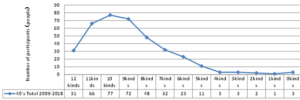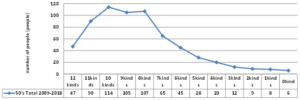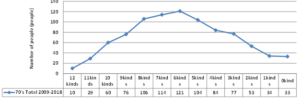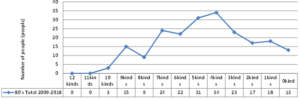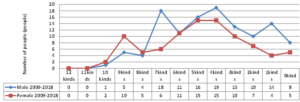ISSN: 2641-6816
Frequency: Continuous
Format: PDF and HTML
Versions: Online (Open Access)
Year first Published: 2018
Language: English
| Journal Menu |
| Editorial Board |
| Reviewer Board |
| Articles |
| Open Access |
| Special Issue Proposals |
| Guidelines for Authors |
| Guidelines for Editors |
| Guidelines for Reviewers |
| Membership |
| Fee and Guidelines |
 |
The Olfactometry Results for Ten Years (2009-2018) In the Yakumo Study by Using the Odor Stick Identification Test
Naomi Katayama1,2,3*, Shoko Kondo4, Yui Nakayama2, Takafumi Nakada5, Seiya Goto3, Satofumi Sugimoto3, Wakako Kinoshita3, Masaaki Teranisi3, Michihiko Sone3, Yasushi Fujimoto3, Hironao Otake6, Hirokazu Suzuki5, Seiichi Nakata7, Tsutomu Nakashima8, Kenji Kondo9, Takaki Miwa10
1Nagoya Women’s University, Nagoya City, Japan
2Graduate School of Nagoya Women’s University, Nagoya City, Japan
3Department of Otorhinolaryngology, Nagoya University Graduate School of Medicine, Nagoya, Japan
4Watanabe Hospital, Mihama town, Noma, Aichi, Japan
5National Center for Geriatrics and Gerontology, Obu, Japan
6Otake Otolaryngology Hospital, Kariya City, Aichi, Japan
7Department of Otolaryngology, Second Hospital Fujita Health University School of Medicine, Nagoya, Japan
8Ichinomiya Medical Treatment & Habitaiton Center, Ichinomiya, Japan
9Kanazawa Medical University, Japan
10Graduate School of Medical Sciences, The University of Tokyo, Japan
Received Date: October 29, 2019; Accepted Date: November 05, 2019; Published Date: November 14, 2019
*Corresponding author: Naomi Katayama, Nagoya Women’s University, Nagoya City, Japan. Email: naomik@nagoya-wu.ac.jp
Citation: Katayama N, Kondo S, Nakayama Y, Nakada T, Goto S, Sugimoto S, Kinoshita W, Teranisi M, Sone M, Fujimoto Y, Otake H, Suzuki H, Nakata S, Nakashima T, Kondo K, Miwa T (2019) The Olfactometry Results for Ten Years (2009-2018) In the Yakumo Study by Using the Odor Stick Identification Test. Adv Nutri and Food Sci: ANAFS-153.
Abstract
For ten years (2009-2018), we have conducted olfactory examination by using the Odor Stick Identification Test in Yakumo town inhabitant medical examination.The Odour Stick Identification Test (OSIT-J) was used to assess odour perception. This test possesses high reliability and validity. The OSIT-J includes 12 different odorants to be identified.As we have already reported, the olfactory test results decrease in the number of correct answers as the age increases. However, from 40’s to 80’s, few studies have clarified the distribution of the number of correct answers according to age. Therefore, this study aimed to compare and calculate olfactory test results for the past 10 years according to age and sex.
A total of 3836 people (1652 males and 2184 females) had a total number of subjects who participated in the Yakumo town resident health examination in 2009-2018. The Odour Stick Identification Test (OSIT-J) was used to assess odour perception. The aromas used in the OSIT-J includes curry, perfume, Japanese cypress, India ink, menthol, rose, wood, stinky socks/sweat, roasted garlic, condensed milk, gas for cooking, and Japanese mandarin orange.
In the forties, the number of perceptions found by most people was 10 out of 12 different smells. Similarly, 10 different smells in 50’s, 9 different smells in 60’s, 6 different smells in 70’s and 4 different smells in 80’s out of 12 different smells were answer of the OSIT-J. Female response was more perceived than male responses. From the present results, it can be said that the olfactory test results need to be evaluated by age, and also by gender.
Keywords: Aging; Gender; Healthy Elderly People; Olfactory Function; Yakumo Study
Introduction
Japan is an ageing society. The proportion of elderly population in Japan will become the highest among the total population in the next ten years. There is a concern that with increasing age, individuals would soon be unable to identify through the sense of smell. Furthermore, nasal congestion and olfactory disorders occurring after inflammation that are caused by allergic rhinitis, modern-day hay fever, and common colds also inhibit the sense of smell [1-3].
Present in a narrow region of the mucosa that covers the inside of the nose (olfactory epithelium) are the olfactory receptor neurons. The dendritic ends (olfactory cilia) of these neurons detect odour molecules that enter the nose via currents of air, which produces an electrical signal. This signal travels up through the bone that forms the ceiling of the nasal cavity (the cribriform plate) via nerve fibres that converge on the olfactory bulb, an enlarged area of nerve cells of the brain that also form olfactory nerves. Signals passing through the olfactory bulb travel to the brain along these olfactory nerves, where the signals are interpreted, and the smell is recognized [4]. The medial aspect of the temporal lobe that remembers smells is also stimulated at this point, and the brain can identify the odour based on a memory of previously experienced smells. In other words, smell identification requires an already-accumulated set of experienced smells [5, 6].
Both olfaction and gustation start to decline in humans around the age of 50-59 years, with 40% of the elderly experiencing a noticeable decline [7]. A person’s first awareness of decline in olfaction as our primary dependence for identification of flavour occurs when one is unable to distinguish foods by taste alone.
Olfaction also performs an important and essential role in our ability to detect dangers, including the smell of leaking gas, the burning odour of fire, and the putrid smell of rotten food. Olfaction is also responsible for enrichment and psychological stimulation in our everyday lives, such as with the scents and smells of foods and flowers [8]. In an already aged society, healthy olfaction is a necessary part of creating a safe and fertile living environment and for improving an individual’s quality of life.
Considering these circumstances, this study aims to understand the age-related decline in olfactory function in participants aged 40-49 years, 50-59 years, 60-69 years, 70-79 years, and 80-89 years. We identified the odours particularly difficult to distinguish for individuals of these age and sex groups past our short-term findings [9-12]. We settled olfactometry result in the Yakumo-cho inhabitants examination for 10 years this time.This resuts might help draw attention to issues faced by individuals in their daily lives and facilitate improvement in their quality of life.
Material and Methods
Participants
The participants were community dwellers who voluntarily participated in the Yakumo Study and had managed their everyday life themselves. The Yakumo Study has been conducted since 1981 as a joint project between the town of Yakumo in Hokkaido and the Nagoya University Graduate School of Medicine. Professionals in the fields of epidemiology, internal medicine, orthopaedics, neuropsychology, ophthalmology, otolaryngology, and urology have joined to the Yakumo Study. The analysed data here were based upon the database from 2005 from the neuropsychology and otolaryngology teams. The participants had been engaged in a variety of jobs, not only white collar but also in agriculture, fishery, and forestry. Therefore, this town can be regarded as representative of today’s Japanese society. From the database, 3836 olfactometry participants (2184 female and 1652male) were selected form data in August, 2009-2018.
Assessment of Odour Identification
The Odour Stick Identification Test (OSIT-J) was used to assess odour perception. This test possesses high reliability and validity [13]. The OSIT-J includes 12 different odorants to be identified. As odour perception is not necessarily culture-free, the Japanese version was employed [14, 15]. The basic procedure resembles that of the San Diego Odour Identification Test [16]. The aromas used in the OSIT-J includes curry, perfume, Japanese cypress, India ink, menthol, rose, wood, stinky socks/sweat, roasted garlic, condensed milk, gas for cooking, and Japanese mandarin orange. Each fragrance was enclosed in microcapsules made of melamine resin. These microcapsules were mixed with an odourless solid cream and then shaped to look like a lipstick. During the inspection test, the examiner applied each odorant to a piece of paraffin paper. After application, the examiner handed the paper to the participant, who would then sniff the paper and identify the odour. Participants selected each answer from a set of cards, each of which listed the name of an odorant, including the correct answer. Each correct answer was scored as one point, with the total performance score ranging from 0 to 12 points.
Statistical Processing
We collected the statistics and handled data of the sense of smell threshold and the taste threshold. The data that was not normally distributed was compared with the uncorrelated Mann-Whitney test of the nonparametric test.
Ethical Review Board
This study was conducted with the approval of the Ethical Review Board (Nagoya women’s university ‘hitowomochiitakennkyuu ni kansuru iinkai’). The approval number is 29-22
Results
Participants Age Distribution
 Figure 1: Age distribution of participant in Yakumo resident examination 2001-2018.
Figure 1: Age distribution of participant in Yakumo resident examination 2001-2018.
Figure 2: Male and female ratio in each age in Yakumo resident examination 2001-2018.
We united olfactometry data for ten years and had a table according to sex and the age of the participant. (Cf. Figure 1 and 2). The distribution of gender by age group was as follows. In the 40’s, 372 participants were 252 females and 120males. In the 50’s, 710 participants were 461 females and 239 males. In the 60’s, 1633 participants were 872 females and 761 males. In the 70’s, 914 participants were 509 females and 405 ales. In the 80’s, 207 participants were 90 females and 117 males.
Assessment of Odour Identification
Participants were tested for their ability to recognize 12 different odors. The results were graphed by age and gender. There were many participants in their 40’s who recognized 10 different kinds of odor. There were a lot of participants who recognized the smell of 10 different kinds in females and 9 different kinds in male. (Cf. Figure 3 and 4.).
Figure 3: Olfactory test result of 40’s in Yakumo resident examination (2009-2018)
Number of correct answers within 12 kinds of odor.
Figure 4: Olfactory test result of 40’s in Yakumo male and female resident examination (2009-2018)
Number of correct answers within 12 kinds of odor.
There were many participants in their 50’s who recognized 10 different kinds of odor. There were a lot of participants who recognized the smell of 10 different kinds in females and 9 different kinds in male (Cf. Figure 5 and 6).
Figure 5: Olfactory test result of 50’s in Yakumo resident examination (2009-2018)
Number of correct answers within 12 kinds of odor.
Figure 6: Olfactory test result of 50’s in Yakumo male and female resident examination (2009-2018)
Number of correct answers within 12 kinds of odor.
There were many participants in their 60’s who recognized 9 different kinds of odor. There were a lot of participants who recognized the smell of 9 different kinds in females and 8 different kinds in male. (Cf. Figure 7 and 8).
Figure 7: Olfactory test result of 60’s in Yakumo resident examination (2009-2018)
Number of correct answers within 12 kinds of odor.
Figure 8: Olfactory test result of 60’s in Yakumo male and female resident examination (2009-2018)
Number of correct answers within 12 kinds of odor.
There were many participants in their 70’s who recognized 6 different kinds of odor. There were a lot of participants who recognized the smell of 8different kinds in females and 6 different kinds in male (Cf. Figure 9 and 10).
Figure 9: Olfactory test result of 70’s in Yakumo resident examination (2009-2018)
Number of correct answers within 12 kinds of odor.

Figure 10: Olfactory test result of 70’s in Yakumo male and female resident examination (2009-2018)
Number of correct answers within 12 kinds of odor.
There were many participants in their 80’s who recognized 4 different kinds of odor. There were a lot of participants who recognized the smell of 5 different kinds in females and 4 different kinds in male (Cf. Figure11 and 12).
Figure 11: Olfactory test result of 80’s in Yakumo resident examination (2009-2018)
Number of correct answers within 12 kinds of odor.
Figure 12: Olfactory test result of 80’s in Yakumo male and female resident examination (2009-2018)
Number of correct answers within 12 kinds of odor.
The olfactory test results of the participants of each age are summarized as shown in Figure 13. Olfactory test results are similar of those in the 40’ws and 50’s, but the recognition level began to fall from the 60’s.It was half in the 70’s and a third in the 80’s (Cf. Figure 13).
Figure 13: Ten years of olfactory test results in Yakumo town by age (2009-2018).
Statistical Processing
We collected the statistics and handled data of the sense of smell threshold Based on the olfactory test results; the normal distribution of the results by age was confirmed by F test. If there is no difference in F test, it was statistically processed using unpaired Student-t test. In addition, when there is a difference in F test, it was statistically processed using unpaired Mann-Whitney test.
Discussion
As expected, the correct identification rate measured using the odor identification test decreased with an increase in age, showing that olfaction declines with an increase in age. This result was similar to that obtained by Ayabe et al. (2005) [17] and shows the validity of the test method used in this study. Our level of sensory recognition of odors is created by the circumstances of our everyday lives [18]. This data provided this time were about the same with our last data which was accepted [9-12].
We collect more data and we want to decide the cut-off level of taste examination and cut-off level of odor examination in future. It was revealed that the sense of smell recognition declined from these findings of 10 years earlier than the taste recognition.
Furthermore, we compared the result of the male and female, and male understood that both the sense of smell recognition and the taste recognition were lower than female in the whole. The sense of smell recognition begins to lower from 60s. It was revealed that the taste recognition was hard to be affected by the age like the sense of smell recognition. It will be necessary to investigate the connection with the lifestyle in future. In addition, we think that more detailed data analysis is necessary, this three classification (normal range, observation required, consultation required) is not enough to understand the taste recognition and the sense of smell recognition.
Conclusion
We performed an examination of olfactometry in Yakumo-cho inhabitant’s medical examination. Odour results of female had better recognition than male. As for the male, odor recognition decreases from 60 years old in particular. In the forties, the number of perceptions found by most people was 10 out of 12 different smells. Similarly, 10 different smells in 50’s, 9 different smells in 60’s, 6 different smells in 70’s and 4 different smells in 80’s out of 12 different smells were answer of the OSIT-J. Female response was more perceived than male responses. From the present results, it can be said that the olfactory test results need to be evaluated by age, and also by gender.
Acknowledgement
This study was conducted by a research aid of Choju-iryo-kenkyu-kaihatsuhi 28-3. And this study was conducted by a research aid of the Japanese Society of Taste Technology2018. We would like to say thank you deeply.
References
- Quint C, Temmel AF, Schickinger B, Pabinger S, Ramberger P, et al. (2001) Patterns of non-conductive olfactory disorders in eastern Austria; A study of 120 patients from the Department of Otorhinolaryngology at the University of Vienna. Wien Klin Wochenschr 113: 52-57.
- Welge-Lüssen A, Wolfensberger M (2006) Olfactory disorders following upper respiratory tract infections; Taste and smell; Au update. Adv Otorhinolaryngol 63:125-13.
- Kallmann FJ, Schonfeld WA, Barrera SE (1944). The genetic aspects of primary eunuchoidism. Am J Ment Defic 1944: 203-236.
- Mori K, Takahashi YK, Igarashi KM, Yamaguchi M (2006) Maps of odourant molecular featuresin the mammalian olfactory bulb. Physiol Pev 86: 409-433.
- Serizawa S1, Ishii T, Nakatani H, Tsuboi A, Nagawa F, et al. (2000) Mutually exclusive expression of an odorant receptor gene in YAC transgenic mice. Nature Neurosci 3: 687-693.
- Serizawa S1, Miyamichi K, Sakano H (2004) one neuron-one receptor rule in the mouse olfactory system. Trends in Genetics 20: 648-653.
- Doty RL, Shaman P, Applebaum SL, Giberson R, Siksorski L, et al. (1984) Smell identification ability; Changes with age. Science 226: 1441-1443.
- Saito S, Ayabe-Kanamura S, Takashima Y, Gotow N, Naito N, et al. (2006) Development of a smell identification test using a novel stick-type odor presentation kit. Chemical Senses 31: 379-391.
- Katayama, S. Kondo, H. Ootake, et al. Odour and Salt Taste Identification in Older Adults: Evidence from the Yakumo Study. Advances in Sciences and Engineering 9: 20-31.
- Katayama, S. Kondo, S. Sugimoto, et al. (2018) Odour and Salt Taste Identification in Older Adults: Evidence from the Yakumo Study in August, 2016. NorCal Open Access Publications Recent Advancement in Food Science and Nutrition Research 1: 28-37.
- Katayama, S. Kondo, Y. Nkayama, et al. (2018) Odour and Salt Taste Identification in Older Adults: Evidence from the Yakumo Study in August, 2015-2017. NorCal Open Access Publications Recent Advancement in Food Science and Nutrition Research: 1: 56-64.
- Katayama N, Kondo S, Nkayama V, et al. (2018) Odour and Salt Taste Identification in Older Adults: Evidence from the Yakumo Study in August, 2014.Journal of Human Virology & Retrovirology 1: 10-13.
- Kobayashi M (2005) The odor Stick Identification Test for the Japanese (OSIT-J): Clinical suitability for patients suffering from olfactory disturbance. Chemical Senses 30: i216-i217.
- Kobayashi M1, Reiter ER, DiNardo LJ, Costanzo RM (2007) A new clinical olfactory function test: cultural influence. Archives of Otolaryngology-Head Neck Surgery 133: 331-336.
- Kobayashi M, Saito S, Kobayakawa T, Deguchi Y, Costanzo RM (2006) Cross-culturalcomparison of data using the Odor Stick Identification Test for Japanese (OSIT-J). Chemical Senses 31: 335-342.
- Murphy C, Anderson AJ, Markison S (1994) Psychophysical assessment of chemosensorydisorders in clinical populations. Olfaction and Taste XI pp 609-613.
- Saito S, Kanamura SA, Takashima Y, Gotow N, Naito N, et al. (2005) Development of a smell identification test using a novel stick-type odor presentation kit:The generation and a sex factor. Journal of Aroma Science and Technology 52-55.
- Yatagai M, Ohira M, Ohira T, Nagai S (1994) Seasonal veriiations of terpene emission from trees and influence of temperature, light and contact stimulation on terpene emission. Chemosphere 30: 1137-1149.

